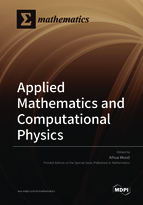Applied Mathematics and Computational Physics
A special issue of Mathematics (ISSN 2227-7390). This special issue belongs to the section "Engineering Mathematics".
Deadline for manuscript submissions: closed (30 June 2021) | Viewed by 33120
Special Issue Editor
Interests: partial differential equations; electromagnetic wave propagation; rarefied gas dynamics; and machine learning
Special Issues, Collections and Topics in MDPI journals
Special Issue Information
Dear Colleagues,
In an age of ever-increasing computing power, there has been a rapid development of powerful computational methods in all areas of engineering and physics. In some cases, increased processing power allows us to address complex problems that not long ago had been considered out of reach for practical purposes. In other cases, novel computing techniques have been developed to approximate more accurately solutions for problems which otherwise would still remain intractable for practical applications. Of particular note is the success of machine learning techniques, which provide a new avenue by which to approach many computational challenges, and which have been widely utilized in a variety of engineering and physics disciplines.
As faster and more efficient numerical algorithms become available, the understanding of the physics and the mathematical foundation behind the new methods will play an increasingly important role. In this Special Issue, we provide a platform for researchers from both academia and industry to present their new and novel computational methods that have engineering and physics applications.
We particularly encourage submissions of novel machine learning techniques that are physics-informed.
Prof. Dr. Aihua Wood
Guest Editor
Manuscript Submission Information
Manuscripts should be submitted online at www.mdpi.com by registering and logging in to this website. Once you are registered, click here to go to the submission form. Manuscripts can be submitted until the deadline. All submissions that pass pre-check are peer-reviewed. Accepted papers will be published continuously in the journal (as soon as accepted) and will be listed together on the special issue website. Research articles, review articles as well as short communications are invited. For planned papers, a title and short abstract (about 100 words) can be sent to the Editorial Office for announcement on this website.
Submitted manuscripts should not have been published previously, nor be under consideration for publication elsewhere (except conference proceedings papers). All manuscripts are thoroughly refereed through a single-blind peer-review process. A guide for authors and other relevant information for submission of manuscripts is available on the Instructions for Authors page. Mathematics is an international peer-reviewed open access semimonthly journal published by MDPI.
Please visit the Instructions for Authors page before submitting a manuscript. The Article Processing Charge (APC) for publication in this open access journal is 2600 CHF (Swiss Francs). Submitted papers should be well formatted and use good English. Authors may use MDPI's English editing service prior to publication or during author revisions.
Keywords
- computational methods
- algorithm
- engineering
- machine learning






